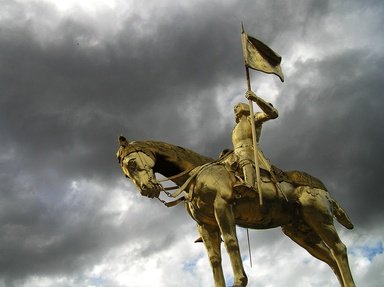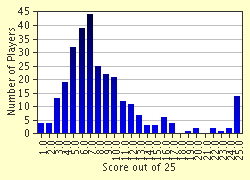Quiz Answer Key and Fun Facts
1. Joan of Arc fought in which war?
2. Joan of Arc was born and raised in what place?
3. Historians of Joan of Arc received an unexpected boon in the mid-nineteenth century when five original versions of this document were found in different libraries in France.
4. Three of the following were actual battle incidents Joan of Arc survived. Which one is false?
5. Which of the following writers did not create a work about Joan of Arc?
6. After capture in battle, which of the following escape strategies did Joan of Arc not try?
7. In terms of enemy casualties, which was Joan of Arc's greatest victory?
8. Charles VII hadn't yet been crowned when he met Joan of Arc although Charles VI had been dead for seven years. Which of the following was not a reason for this odd delay?
9. Two of Joan of Arc's letters have survived. Who were the intended recipients?
10. Joan of Arc's contemporaries describe her as wearing "white armor." What does that mean?
11. Joan of Arc put an end to a string of English victories that had begun fourteen years earlier with this famous battle fought on St. Crispin's day.
12. Joan of Arc's military career lasted how long?
13. England's most important ally was which French speaking duke?
14. On one level, the French and English were fighting over interpretations of a law decreed by which fifth century Frankish ruler?
15. Joan of Arc testified to visions of three saints. How many of these has the Catholic Church recognized, without interruption, as historical saints today?
16. During Joan of Arc's time England's Henry VI was a small boy. Who ruled as regent?
17. Two other people who became legendary figures fought in Joan of Arc's battles. By what names are they now best remembered?
18. Joan of Arc asked Charles VII to exempt her hometown from taxes. For how long did the crown fulfill her request?
19. After his coronation Charles VII made Joan a noblewoman, granted her a coat of arms, and changed her name. What new name did she receive?
20. What was Joan of Arc before she entered public life?
21. How old was Joan of Arc when she first led the army?
22. Joan of Arc's birthday is often reported as January 6. Is this date reliable?
23. Why was Joan of Arc convicted of heresy rather than witchcraft?
24. Joan of Arc first went to Orleans with a relief expedition financed by Charles VII's mother-in-law, who was queen of which country?
25. How did Joan of Arc first gain Charles VII's confidence?
Source: Author
donnerteaparty
This quiz was reviewed by FunTrivia editor
Lanni before going online.
Any errors found in FunTrivia content are routinely corrected through our feedback system.


